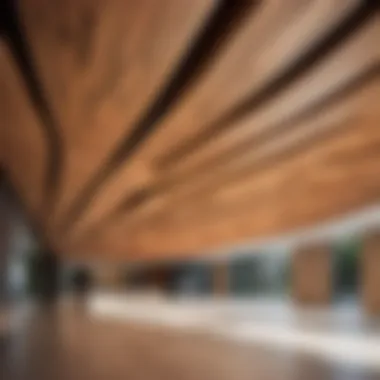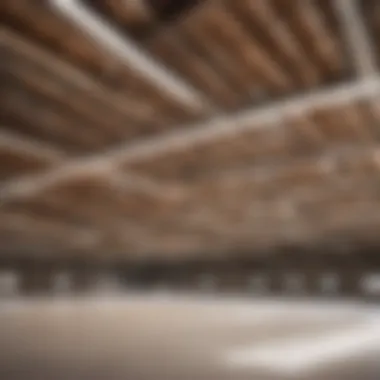Materials:
- Hollow beams (exact measurements: 4 inches x 6 inches x 10 feet) x 10 pieces
- Ceiling mounting brackets x 20 pieces
- Wood screws (size: 2.5 inches) x 40
- Drill machine
- Level
- Measuring tape
- Pencil
DIY Steps:
- Measure the ceiling area to determine the placement of the hollow beams.
- Mark the positions where the beams will be installed using a pencil.
- Attach the ceiling mounting brackets to the marked positions securely using wood screws.
- Lift each hollow beam into place on the ceiling mounting brackets.
- Secure the beams by screwing them into the brackets using wood screws.
- Ensure each beam is level and aligned with adjacent beams for a cohesive look.
- Repeat the process for all the remaining beams until the entire ceiling area is covered.
Technical Aspects:
- Timing: Allocate 2-3 hours for proper installation of the hollow beams.
- Tools: Drill machine for attaching brackets and screws, level for ensuring alignment, measuring tape for accurate placement.
- Critical techniques: Ensure beams are securely fastened to brackets for safety and structural stability.
DIY Project Process:


- Sequential Steps:
- Begin by measuring and marking the ceiling area, and install the mounting brackets.
- Lift and secure each hollow beam one by one, making sure they are level and aligned.
- Double-check the installation for any loose beams or misalignments.
- Troubleshooting Tips: If beams are not aligning correctly, adjust the placement of the brackets or beams accordingly. If screws are not fastening securely, use larger or longer screws for better stability.
Introduction


Ceiling design plays a vital role in shaping the ambiance and aesthetics of any interior space. Among the various elements that contribute to a well-designed ceiling, utilizing innovative applications of hollow beams stands out as a distinctive and versatile approach. Hollow beams not only enhance the structural integrity but also offer a visually appealing aspect to ceilings, creating unique and contemporary spaces that captivate the eye.
Definition of Hollow Beams
Hollow beams are structural elements used in construction and interior design that have an internal void, giving them a hollow appearance. Unlike solid beams, hollow beams provide a lighter alternative without compromising strength, making them ideal for various applications in ceiling design. These beams come in a range of materials such as wood, metal, and composites, each offering distinct properties and design possibilities.
Significance of Ceiling Design
The significance of ceiling design goes beyond mere aesthetics; it influences the overall feel and functionality of a room. By incorporating innovative applications of hollow beams, homeowners can transform their living spaces into visually stunning and structurally sound environments. Ceiling design can impact acoustics, lighting, and spatial perception, making it a crucial component of interior design that shouldn't be overlooked.
Purpose of the Article
Structural Advantages


Enhanced Load-Bearing Capacity
Increased Strength for Support
When it comes to Increased Strength for Support, hollow beams prove to be a game-changer in reinforcing the structural integrity of ceilings. This specific aspect plays a pivotal role in providing exceptional resilience and stability to the overall construction. The key characteristic of Increased Strength for Support lies in its ability to withstand heavy loads and maintain stability over an extended period, making it a highly advantageous choice for ensuring the longevity and durability of the structure. One unique feature of Increased Strength for Support is its capability to distribute weight efficiently, thereby reducing any potential strain on the ceiling framework. While it contributes significantly to the robustness of the ceiling design, some considerations may include the added costs associated with materials that exhibit higher strength properties.
Reduced Structural Weight
Another vital aspect to consider is the Reduced Structural Weight offered by hollow beams, which contributes to optimizing the overall load-bearing capacity of the ceiling structure. By minimizing the weight without compromising strength, hollow beams enable architects and designers to implement innovative and sustainable design solutions. The key characteristic of Reduced Structural Weight lies in its ability to enhance spatial efficiency and reduce the overall strain on the building's foundation. This characteristic makes it a popular choice for projects that prioritize sustainability and resource efficiency. One distinct feature of Reduced Structural Weight is the ease of handling and installation, which streamlines the construction process while maintaining structural integrity. However, potential disadvantages may include the need for meticulous planning to ensure that the reduced weight does not compromise the safety or functionality of the ceiling structure.
Flexibility in Design
Exploring the realm of Flexibility in Design, we uncover how hollow beams offer a myriad of design possibilities to accentuate the aesthetic appeal of ceiling structures. By focusing on Curved Beam Applications, designers can introduce graceful curves and flowing lines that add a touch of elegance and sophistication to interior spaces. The key characteristic of Curved Beam Applications is their ability to create organic forms that seamlessly integrate with the surrounding architecture, offering a dynamic visual impact. This flexibility makes it a popular choice for projects seeking to evoke a sense of fluidity and movement within the design scheme. One unique feature of Curved Beam Applications is the ability to enhance spatial perception and create visually engaging focal points within the ceiling design. While the advantages are evident in enhancing overall aesthetics, designers must consider potential disadvantages such as increased complexity in fabrication and installation.
Customizable Profiles
In the realm of Customizable Profiles, hollow beams provide designers with endless opportunities to tailor the visual and structural aspects of ceiling designs to suit specific preferences and functional requirements. The key characteristic of Customizable Profiles lies in their adaptability to diverse design styles, allowing for customization that aligns with various architectural themes and interior concepts. This flexibility makes Customizable Profiles a beneficial choice for projects that prioritize personalization and uniqueness in design. One unique feature of Customizable Profiles is the ability to incorporate intricate details and textures that add depth and dimension to the ceiling space. While the advantages are evident in offering tailored solutions, designers should be mindful of potential disadvantages such as increased fabrication complexity and costs associated with custom designs.
Acoustic Benefits
Addressing the significance of Acoustic Benefits in ceiling design, hollow beams emerge as a valuable solution for enhancing sound insulation and acoustical performance within interior environments. By integrating acoustic principles into the design process, designers can create spaces that promote comfort and tranquility while minimizing external noise disturbances. The acoustic properties of hollow beams contribute to reducing reverberation and amplifying speech clarity, making them a desirable choice for environments that require optimal sound control. This section further illuminates how hollow beams can effectively manage sound transmission and improve acoustical quality within diverse architectural settings.
Material Selection
In the realm of ceiling design, material selection stands as a pivotal decision, influencing both form and function. The choice of materials not only dictates the aesthetic appeal but also plays a crucial role in the structural integrity of the ceiling. When considering hollow beams for ceiling design, the material selection process becomes even more critical due to the unique characteristics and requirements of hollow beams.
Wooden Hollow Beams
Wooden hollow beams present a timeless charm and warmth to interior spaces, making them a popular choice for ceiling designs. Within the realm of wooden hollow beams, options like Oak, Cedar, and Pine stand out due to their distinct properties and aesthetic contributions.
Oak
Oak, known for its strength and durability, is a preferred choice for those seeking a robust yet elegant ceiling design. Its dense grain structure not only enhances the visual appeal but also provides excellent load-bearing capabilities, essential for ceiling applications. Oak's natural golden hue adds a touch of sophistication to any space, creating a luxurious ambiance that resonates with classic elegance.
Cedar
Cedar, revered for its natural resistance to insects and decay, offers a practical yet stylish option for ceiling designs. The distinct aroma of cedar further adds a comforting element to interior spaces, fostering a relaxing atmosphere. Its light and airy appearance make it an ideal choice for those aiming to create a sense of openness and lightness in their living spaces.
Pine
Pine, with its affordability and versatility, appeals to those looking for a budget-friendly yet visually appealing option for their ceiling beams. Its light color and natural knots bring a rustic and cozy feel to any room, perfect for creating a charming and inviting ambiance. While Pine may be softer compared to Oak and Cedar, its willingness to take on various finishes and treatments make it a customizable choice for tailored ceiling designs.
Metal Hollow Beams
In contrast to wooden hollow beams, metal hollow beams offer a modern and industrial aesthetic to interior spaces. With options like Steel, Aluminum, and Copper, the allure of metal lies in its sleekness and contemporary appeal, making it a favored choice for those seeking a bold and edgy statement with their ceiling design.
Steel
Steel, renowned for its strength and durability, establishes itself as a stalwart choice for heavy-duty applications in ceiling design. Its ability to withstand high loads and harsh environments makes it an ideal candidate for industrial-inspired or contemporary ceiling designs seeking a resilient and long-lasting solution. The sleek and modern appearance of steel beams adds a touch of urban sophistication to any space.
Aluminum
Aluminum, known for its lightweight nature and corrosion resistance, offers a practical yet stylish choice for ceiling beams. Its malleability allows for intricate and detailed designs, making it a versatile option for those looking to incorporate unique shapes and patterns into their ceiling design. Aluminum's ability to reflect light adds a sense of brightness and airiness to spaces, ideal for creating a contemporary and spacious ambiance.
Copper
Copper, with its rich and luxurious appearance, brings a touch of opulence to ceiling designs. The warm reddish-brown hue of copper develops a beautiful patina over time, adding character and depth to the space. Apart from its visual appeal, copper also possesses antimicrobial properties, making it a hygienic choice for ceilings in spaces where cleanliness is paramount. The versatility of copper extends to its ability to be formed into intricate designs, allowing for the creation of bespoke and ornate ceiling features.
Composite Materials
For those seeking a blend of durability and innovation in their ceiling design, composite materials like Fiber-Reinforced Polymers and Engineered Wood Products offer a contemporary solution. Combining the strengths of different materials, composite hollow beams provide a unique combination of characteristics that cater to the demands of modern architectural and design preferences.
Fiber-Reinforced Polymers
Fiber-Reinforced Polymers (FRP) introduce a new dimension to ceiling design, blending lightweight properties with high strength and durability. The inherent versatility of FRP allows for the creation of intricate and dynamic ceiling designs that push the boundaries of traditional beam materials. FRP's resistance to corrosion, moisture, and chemical agents makes it a suitable choice for both interior and exterior applications, ensuring longevity and low maintenance for ceiling structures.
Engineered Wood Products
Engineered Wood Products (EWPs) combine the natural beauty of wood with enhanced structural performance, offering a modern twist to traditional wooden beams. By utilizing advanced manufacturing techniques, EWPs achieve greater strength and stability compared to natural wood, making them a reliable choice for demanding ceiling applications. The sustainability of EWPs also appeals to eco-conscious consumers, providing a renewable and environmentally friendly option for contemporary ceiling designs.
Each material discussed - from Oak and Cedar to Steel and FRPs - brings its own set of benefits and considerations to the table, shaping the narrative of modern ceiling design through the lens of material innovation.
Installation Techniques
When it comes to utilizing hollow beams for ceiling design, the installation techniques play a crucial role in ensuring both functionality and aesthetics. The method chosen for installing hollow beams can significantly impact the overall look and structural integrity of the ceiling. Skillful installation techniques can bring out the best in hollow beams, creating visually stunning and durable ceiling designs.
Concealed Mounting Systems
Concealed mounting systems are a popular choice for installing hollow beams in ceilings. These systems offer a seamless and clean look by hiding the hardware used to secure the beams. By using concealed mounting systems, the focus remains on the elegance of the beams themselves rather than the installation elements. This technique provides a sleek and polished finish to the ceiling, enhancing the modern and minimalistic appeal of the space. Additionally, concealed mounting systems ensure the structural stability of the hollow beams without compromising the overall design aesthetic.
The benefits of concealed mounting systems include improved aesthetics, as there are no visible fasteners or brackets disrupting the clean lines of the ceiling. This technique also minimizes the risk of dust accumulation within the beam joints, making maintenance easier. When considering concealed mounting systems for hollow beams, it is essential to consult with professionals to ensure proper installation and adherence to safety standards.
Exposed Fastener Methods
On the other hand, exposed fastener methods for installing hollow beams offer a striking contrast to concealed mounting systems. Exposed fasteners can add an industrial and rugged look to the ceiling, perfect for spaces aiming for a more raw and unfinished aesthetic. By showcasing the hardware used to secure the beams, this method highlights the unique design elements of the ceiling, creating a visually interesting focal point.
Exposed fastener methods are known for their simplicity and cost-effectiveness compared to concealed mounting systems. These methods allow for easier access to the beams for potential adjustments or replacements in the future. However, it is essential to carefully choose the style and finish of the fasteners to ensure they complement the overall design scheme of the space.
When opting for exposed fastener methods, consider the visual impact you want to achieve in the room. The contrast between the beams and the fasteners can add a layer of depth and character to the ceiling, making it a standout feature in the interior design. Additionally, proper installation and regular maintenance are essential to prevent any issues arising from exposed fastener methods over time.
Design Inspirations
In the realm of interior design, the significance of design inspirations cannot be overstated, especially when it comes to ceiling design with hollow beams. Design inspirations serve as the creative foundation for transformative and captivating living spaces. When it comes to utilizing hollow beams in ceiling designs, drawing inspiration from various sources can elevate the overall aesthetic and enhance the functional aspects. A careful selection of design inspirations can dictate the ambiance and visual impact of a room, making it crucial to consider specific elements that align with the desired interior theme. Introducing unique elements like minimalist ceiling beam styles can create a sleek and contemporary look, emphasizing simplicity and understated elegance.
Minimalist Ceiling Beam Styles
Minimalism in ceiling beam styles embodies a sophisticated and refined approach to interior design. Characterized by clean lines, geometric shapes, and a focus on functionality, minimalist styles are ideal for creating a sense of openness and harmony in a space. When incorporating minimalist ceiling beam styles using hollow beams, attention to detail is paramount. Choosing slender profiles, smooth finishes, and neutral color palettes can achieve a minimalist aesthetic that exudes modernity and tranquility. The key benefits of minimalist styles include creating an illusion of spaciousness, promoting visual balance, and allowing other design elements to shine without overwhelming the space.
Rustic and Industrial Themes
For those seeking a more rugged and textural appeal in their interiors, rustic and industrial themes provide a unique contrast to the sleekness of minimalist styles. Incorporating hollow beams with a weathered finish, exposed hardware, and rugged textures can infuse a space with warmth, character, and a sense of history. Rustic and industrial themes add a touch of authenticity and raw beauty to ceiling designs, showcasing the beauty of imperfections and aged materials. Considerations such as distressed wood, metal accents, and vintage lighting fixtures can contribute to the overall charm and storytelling aspect of the space.
Incorporating Lighting Features
Lighting plays a pivotal role in highlighting the architectural details and ambiance of a room, making it a crucial element to consider when integrating hollow beams into ceiling designs. Incorporating lighting features within hollow beams offers a dual functionality of illuminating the space and showcasing the structural beauty of the beams themselves. From recessed LEDs for subtle accent lighting to statement chandeliers for dramatic focal points, the possibilities are endless when merging lighting elements with hollow beams. Careful positioning of lighting fixtures can enhance the visual appeal of the beams, casting captivating shadows and enhancing the overall atmosphere of the room.
Maintenance Tips
Cleaning and Dusting
Cleaning and dusting are fundamental maintenance practices that uphold the visual appeal of hollow beams. Dust accumulation not only dulls the appearance of beams but can also diminish their structural integrity over time. To combat this, a regular cleaning schedule involving gentle dusting with a soft cloth or a feather duster can prevent particles from settling into crevices. For a more thorough clean, a mild solution of water and gentle soap can be used to wipe down the beams, ensuring a squeaky-clean finish without damaging the materials.
Inspecting for Damage
Inspecting for damage is another crucial facet of maintenance that shouldn't be overlooked. Periodic inspections allow you to identify any signs of wear and tear, such as cracks, warping, or discoloration, which could indicate underlying issues in the beams. By scrutinizing the beams for these imperfections, prompt action can be taken to address any damages before they escalate, preserving the structural integrity of the ceiling design. Additionally, inspecting for damage provides an opportunity to assess the overall condition of the beams and detect early warning signs of potential maintenance requirements, ensuring the longevity and functionality of the hollow beams.





